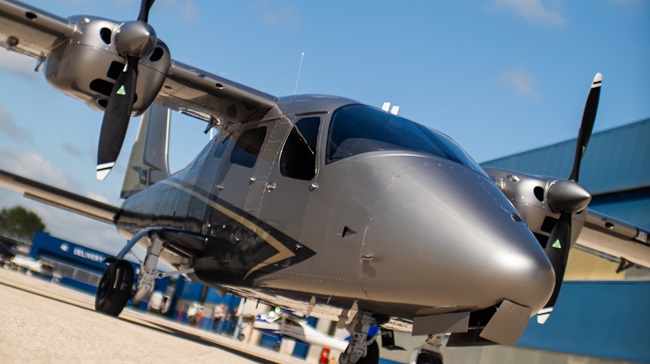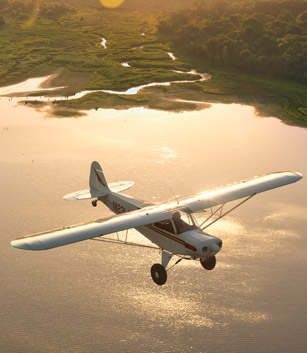
When Darin Hart hears his Super Legend—the king of the American Legend Aircraft line of Cub-alike tailwheel airplanes—he hears in his heart a Harley-Davidson motorcycle. That’s because a Harley, Hart says, can carry you through the fresh breezes of the countryside and bring you back with your mind cleansed of worries. With the right door fully open (the bottom half down, the top half latched up to the wing) and the left upper half open, the Super Legend does that, too. Both have tandem seating for two.
Improper rudder use is indicated by the wind moving sideways through the cabin, in one window and out the other. I experienced that in photo formation for this article when I used the rudder to tweak the aircraft’s position in relation to AOPA Senior Photographer Mike Fizer’s camera, sideslipping right and left beneath Fizer’s lead aircraft. With my left elbow resting on the half-open window, my hand was in perfect position to control with two fingers the small throttle on the left cabin wall. Someone on the ground near Sulphur Springs, Texas, an hour east of Dallas had just cut their grass; I could smell it from 1,000 feet. It was a Harley experience except there were no bugs in my teeth.
The out-the-door price with the most often requested options is $170,000. Put another way, the Super Legend costs the same as a high-end, custom-made motorcycle—but its top speed is legal.
Forty feet above me in the formation was the original Legend Cub previously featured in AOPA Pilot (“Cub-alikes are Better, Faster,” May 2006 AOPA Pilot). Although my Super Legend sported only 15 more horsepower than the 100-horsepower Continental O-200 Legend Cub, it was obvious I had the power advantage. The ground-adjustable Sensenich carbon fiber propeller had a cruise-performance cartridge in it that, when installed, sets blade angle; two other cartridges are available to set the prop for best climb performance, or to set it halfway between climb and cruise performance. I could easily catch up, and when I was asked to take over as lead aircraft, Hart asked me to slow down. Most of the formation flight was flown at 70 mph. The Super Legend typically sees 98 mph to 105 mph in cruise. Asked what altitude gives him the most speed, Hart laughed and said the Cub rarely is flown above 1,000 feet.
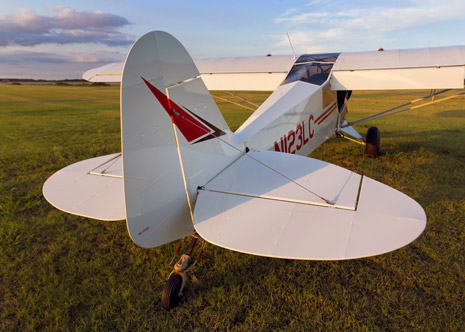
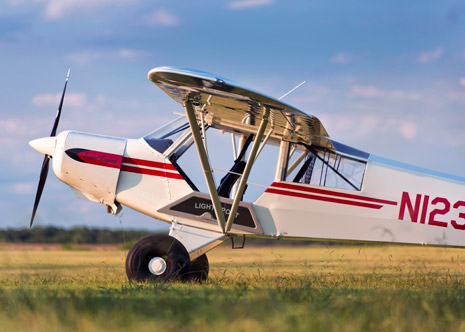
The 115-horsepower Lycoming engine allows the Super Legend to perform with nearly the same power-to-weight ratio as the 150-horsepower, 1,750-pound PA–18 Super Cub, since Light Sport Aircraft rules limit the Super Legend to 1,320 pounds. That means spectacularly short takeoffs (250 feet) and steep climbs are possible, although the Super Legend has a smaller useful load than the original Super Cub. Hart has tested the aircraft to 1,750 pounds in case he ever wants to certify it in the Primary category. That category, unlike the LSA category, requires the pilot to have an FAA medical certificate. You can build the Super Legend at the factory as a kit with an out-the-door price of $160,000. If you have an FAA medical, you can then fly it as an Experimental amateur-built aircraft with a greater maximum gross weight of 1,750 pounds.
Hart considers the engine the second most important change compared to the Legend Cub. The most important one is flaps, operated by a lever coming down on the left from the cabin ceiling. Settings are 20 and 45 degrees. Other changes include a larger horizontal stabilizer and elevator, a small baggage door (the baggage compartment holds 75 pounds), and an adjustable sliding front seat made from bungee cords.
Another important change came from his staff. Hart’s administrative assistant, Dale Manning, spends eight hours a day keeping office matters in line, and asked Hart for a bungee seat made of bungee cords. Hart thought it was such a good idea that he built one for the Super Legend. The seat has a leather cover over the cords; the combination is both comfortable and cool, since air can easily circulate around the bungee cords. The back seat is a sling seat.
Since the goal was a Light Sport aircraft that would compete well with Super Cubs found in Alaska, Hart went there to see how pilots modify them. One of the most important features he found is now on the Super Legend—a greenhouse skylight over both the front and back seats. Another is a cargo tube extending through the baggage compartment into the tail for fishing rods or rifles.
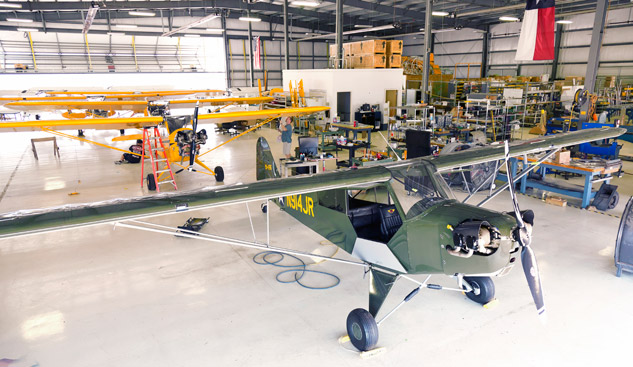
Flying the Super Legend
Steerable tailwheels normally ease the taxiing workload, but I found it difficult at first. I learned on my third taxi that the rudder pedals required an aggressive push, and then the aircraft is perfectly controllable. Before I left, new springs were under consideration to make the tailwheel steering easier and more responsive. Because I occasionally found myself headed in the wrong direction, I needed the brakes, and American Legend has faithfully reproduced the heel brakes from the original Piper Cub that are located on the carbon fiber floor, separate from the rudder pedals.
Personally I would opt for American Legend’s $1,200 toe brakes that operate, as on most aircraft, by pushing the tops of the rudder pedals. Having said that, toe brakes—if accidentally pushed while steering the tailwheel on the ground—can result in tipping the aircraft on its nose.
Takeoff is accomplished by selecting one notch (20 degrees) of flaps, raising the tail during the initial takeoff roll, and rotating at 35 mph (stall speed is 32 mph), then climbing at 60 mph. Coming back, you’ll want 60 mph on downwind (flaps can be deployed as fast as 80 mph), then fly final at 50 to 55 mph—slower if you are trying to make a precise, short landing. Hart approached at 40 to 45 mph while doing landings for our photos.
The factory has a grass runway available at the Sulphur Springs Municipal Airport. I hadn’t landed a tailwheel airplane in a year or two, and followed my usual practice of looking down the runway to judge the height above the runway. I leveled off high and had a high sink rate from three feet on down, with the touchdown softened by steel springs in the landing gear and the large 26-inch tires. It passed as a normal landing. I had forgotten the most helpful tip for landing a Cub—look out the door to see how close you are to the grass.
With the economic downturn, American Legend is producing fewer than two aircraft a month, but was up to seven a month when the economy tanked.
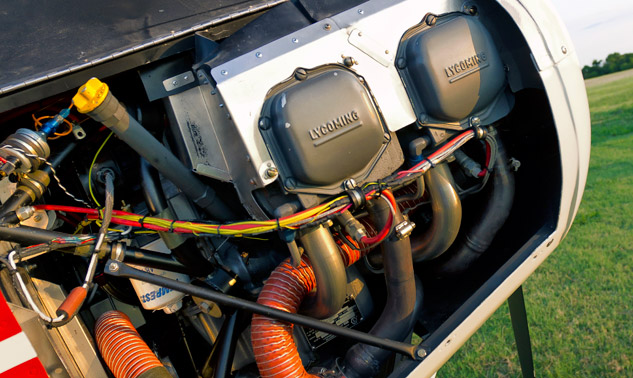
A high-tech Cub
Avionics options include the 10-inch Dynon SkyView glass cockpit for $22,900 or the Garmin GX3 glass cockpit for $24,900. Both include synthetic vision with datalink capability for a few thousand more. Most of the five ordered so far have steam-gauge instruments with a Garmin aera 796 ($1,600).
You can even order a $7,900 TruTrak Digiflight II two-axis autopilot, and sit back to watch weather and traffic on your glass cockpit screens. My favorite option is the AeroLEDs landing lights with pulse ($3,950) that “wig-wag” first one light, then the other on the opposite wing. You’ll look like a Gulfstream on final.
The aircraft easily converts to a seaplane with either Legend 1500 straight floats ($27,500) or Legend 1500A amphibious floats ($37,500). If you prefer snow to water, Trick Air 1500 wheel penetration skis are available for $5,900.
Standard on the Super Legend Cub is carbon fiber construction for the floor boards, doors, interior, baggage compartment, and engine cowling. You’ll also get a parking brake, 30 gallons of fuel (the Legend Cub model carries only 20), a fuel selector with Left and Right or Both positions, dual controls, and an instrument panel that has been tilted forward for extra room. That last option doesn’t mean it is any easier to get into the Super Legend than the former Piper Cub models. You’ll need entry and egress training, and appreciate the value of going on a diet and exercising.
Hart knows he is selling not just a utility airplane, but an experience—in particular, the Cub experience.
“I call them therapy airplanes. You can have one of those rotten days where everything goes bad for you, and then you can go out and fly for 30 minutes or an hour, do a dozen takeoffs and landings, fly low and slow and see the scenery—
just for the enjoyment and fun of it. You come back with a different attitude.
“It’s a lot cheaper than going to see a psychiatrist,” Hart said.
Email [email protected]
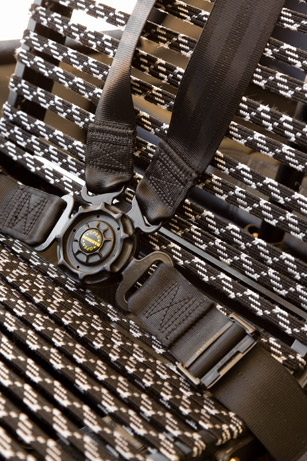
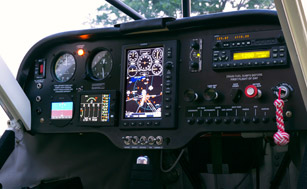
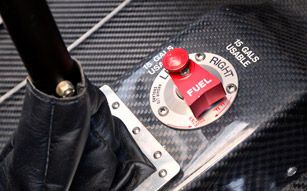
SPEC SHEET
American Legend Super Legend (LSA)
Base price: $146,800
Price as tested: $174,000
Specifications
Powerplant | 115 hp Lycoming O-233
Recommended TBO | 2,400 hr
Propeller | 76 in dia ground adjustable Sensenich
Length | 22 ft 5 in
Height | 6 ft 7 in (9 ft 8 in on floats)
Wingspan | 35 ft 6 in
Wing area | 179.8 sq ft
Wing loading | 7.3 lb/sq ft
Power loading | 11.48 lb/hp
Seats | 2 tandem
Cabin length | 8 ft 6 in
Cabin width | 2 ft 4 in
Cabin height | 4 ft 2 in
Empty weight | 845 lb
Empty weight, as tested | 862 lb
Max gross weight | 1,320 lb
Useful load | 475 lb
Useful load, as tested | 458 lb
Payload w/full fuel | 295 lb
Payload w/full fuel, as tested | 278 lb
Max takeoff weight | 1,320 lb
Max landing weight | 1,320 lb
Fuel capacity, std | 32 gal (30 gal usable) | 192 lb (180 lb usable)
Baggage capacity | 75 lb
Performance
Takeoff distance, ground roll | 280 ft
Max demonstrated crosswind component | 13 kt
Rate of climb, sea level | 900 fpm
Max level speed, sea level | 115 mph
(100 KTAS)
Cruise speed/endurance w/45-min rsv, std fuel
(fuel consumption)
@ 75% power, best economy |
98 mph/4.5 hr
6,000 ft | (34 pph/5.7 gph)
@ 55% power, best economy |
92 mph/5.5 hr
6,000 ft | (29 pph/4.8 gph)
Max operating altitude | 15,000 ft
Service ceiling | 15,000 ft
Landing distance over 50-ft obstacle | 630 ft
Landing distance, ground roll | 330 ft
Limiting and Recommended
Airspeeds
VX (best angle of climb) | 50 mph
VY (best rate of climb) | 68 mph
VA (design maneuvering) | 94 mph
VFE (max flap extended) | 80 mph
VNO (max structural cruising) | 94 mph
VNE (never exceed) | 138 mph
VR (rotation) | 35 mph
VS1 (stall, clean) | 32 mph
VSO (stall, in landing configuration) | 28 mph
For more information: Contact American Legend Aircraft Company, 1810 Piper Lane, Sulphur Springs, Texas 75482; telephone 903/885-7000; e-mail [email protected]; www.legend.aero.
All specifications are based on manufacturer’s calculations. All performance figures are based on standard day, standard atmosphere, sea level, gross weight conditions unless otherwise noted.
Extra: The airplane meets the weight requirements of the Light Sport category, resulting in a spirited climb rate.

